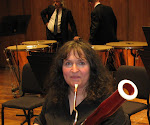When I was in high school I listened to Bernard Garfield's recordings of the Weber Andante and Ronda and the Mozart Bassoon Concerto constantly. (If you're not familiar with these great recordings, they're on YouTube.) He showed me, through his beautiful and immaculate playing, what the bassoon was capable of. Being naive at the time, I saw no reason why I shouldn't be able to do exactly what he was doing. I wrote him a letter expressing my appreciation, and he replied with a piece of advice. He told me to learn to make good bassoon reeds, and then I'd become "an ace"!
Luckily for me, I grew up in the state of New York which offered a fantastic program for high school aged musicians called the NYS School of Orchestral Studies. (Sadly, this program was discontinued due to lack of funding in 2020 after a 50-year run). This was like an augmented version of all state, with New York state students being chosen for the program through competitive auditions. We were housed at Skidmore College in Saratoga, NY--the summer home of the Philadelphia Orchestra, and we were coached by the legendary principals of the Philadelphia Orchestra. Such an incredible opportunity!
It was daunting to be spending the summer among such great artists. John de Lancie, longtime principal oboist of the Philadelphia Orchestra, coached the woodwinds. He was tough! He expected technical precision, accurate intonation and on-time attacks no matter what. We bassoonists were terrified during his sectionals, because he'd make us play alone if he suspected anything was less than perfect. I think it was during his sectionals that I began to comprehend how challenging it would be to become a professional woodwind player. But I lived through it somehow, without giving up on my dream of becoming an orchestral bassoonist.
Bernard Garfield coached the bassoons. He was easier on us than Mr. de Lancie, partly due to his temperament, I think, and partly due to his understanding of what it's like for students to find out what's expected of bassoonists at a high level. He spoke of rhythm, phrasing, sound, and all other aspects of bassoon orchestral playing. He took the time to hold a special seating audition to determine which of us would play principal on Mahler 1 in our final concert. That audition was unspeakably nerve-racking, but it was all part of the learning experience. One of the works we played that he coached us on was Tchaikovsky Symphony No. 4. He referred to the 2nd movement bassoon solo as "the gem of the orchestral literature" for bassoonists.
One evening I walked into the lobby of our Skidmore College dormitory where, much to my surprise, I witnessed Mr. Garfield playing the piano accompaniment for one of his Philadelphia Orchestra colleague's son who was playing a Vivaldi violin concerto. Not only was this man the bassoon hero of that era, but he also mastered the piano!
One of the great benefits of the School of Orchestra Studies was that we were allowed to attend all rehearsals and concerts of the Philadelphia Orchestra. My musical standards rose considerably from observing those rehearsals and concerts. One concert stood out....I was sitting next to a violin student who was learning to appreciate the bassoon. With our rigorous schedule of rehearsing, theory classes, sectionals, practicing, etc., sometimes it was difficult to stay awake while sitting in the audience. The Ravel Piano Concerto was being performed, and my fellow student had fallen asleep. When Bernard Garfield began the famously fast 16th note passage in the 3rd movement, my violinist friend suddenly awakened, sat bolt upright and loudly whispered, "I didn't know a bassoon could GO that fast!!!"
Later I explained to my friend that most bassoons can't go that fast, but this was Bernard Garfield. The passage is actually written for 2 bassoons to trade off. Some orchestras have both bassoons play the entire passage in unison. But Bernard Garfield took on the entire frightful solo by himself, and nailed it.
At the School of Orchestral Studies I became accustomed to that solid, pleasantly resonant sound of his 7,000 series Heckel bassoon. His tone was always sweet and perfectly centered. The goal of each note being perfectly placed--technically, tonally, pitch-wise, resonance-wise--that was a lesson I carried with me from Bernard Garfield.
Because he was so well known, some of his quips were widespread. A man of great wit, he reportedly advised certain aspiring bassoonists to "turn it into a lamp!" (spoken in his thick NY accent). More seriously, he reportedly advised young bassoon students to go into music as a career "only if you can't imagine yourself doing anything else".
My college years were spent at Eastman where I studied with K. David Van Hoesen. Even though I was not officially one of Mr. Garfield's students, I consider him to have been a strong influence throughout the years, which is likely true of most bassoonists. Just yesterday I re-familiarized myself with his Weber recording, marveling at the timeless awe that he inspires. And whenever I balk at the never-ending task of reedmaking, I remind myself that he told me I could be an ace if I mastered it!









